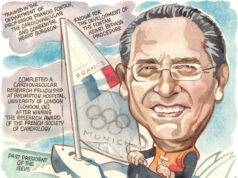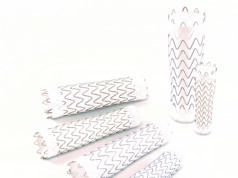
“There is no doubt in my mind that working together rather than competing against each other will not only be in our best interests but also provide better patient care,” Ali AbuRahma tells Vascular News, contemplating his goal of encouraging multispeciality involvement in vascular surgery when he assumes the role of Society for Vascular Surgery (SVS) president. AbuRahma details various aspects of his career so far, covering his early interest in cardiac surgery through to his involvement in the recently-published SVS guidelines on extracranial cerebrovascular disease management. Based on 40 years of experience, he also offers advice to younger surgeons in the field, encouraging an open-mindedness towards new, evidence-based therapies and skills.
What led you to pursue a career in vascular surgery?
After I finished high school and began thinking of my future career, I was very interested in either becoming a maths teacher or engineer, since maths was always my top subject during school. However, my uncle, who was the principal of the school at that time, advised me differently, emphasising the fact that I came from a family that was not well-to-do financially, and he suggested I would not be able to survive and take care of the family being a maths teacher or even an engineer. He convinced me to go to medical school. During my medical school years in Alexandria, I was very impressed with the work of cardiac surgeons. However, I was also negatively impacted by the unsatisfactory outcomes after many of the cardiac surgeries I witnessed during those early years of my career. When I moved to the USA, I worked with a chair who was a cardiovascular surgeon during my surgical residency. He suggested I try vascular surgery because it would give me the career I wanted and had commonality with cardiac surgery. That is what eventually led me to pursue a career in vascular surgery, which I do not regret.
Who have been your professional mentors and what have they taught you?
For my technical skills in vascular surgery, I would give the credit to the late Edward Diethrich of the Arizona Heart Institute, who was a very gifted surgeon. For my clinical judgment and growth in my early career, I give the credit to the late James Boland, chair of surgery at West Virginia University at the Charleston campus for over 40 years. For my academic career and advances, I would give the credit to the late John Bergan and Bob Rutherford for encouraging an interest in academia. I looked to them as mentors and I tried to follow their footsteps in my early career. Also, I received a great deal of guidance and support from Frank Veith over the past 30 years.
How do you anticipate the field of vascular surgery might change in the next decade, and what developments would you most like to see realised?
With endovascular intervention constituting a major portion of the vascular practice of many young vascular surgeons and a significant portion of senior vascular surgeons, endovascular intervention will continue to be a major part of our practice. Over the past decade, with the introduction of branched/fenestrated endovascular grafting for the treatment of complicated suprarenal and thoracoabdominal aortic aneurysms and aortic dissection, I can see endovascular therapy replacing a significant bulk of open surgery in this area.
What are the biggest challenges currently facing vascular surgery?
I believe the drive for endovascular intervention by some specialists from other disciplines such as interventional radiology and interventional cardiology—who might not be qualified to do these procedures because of a lack of basic training during their fellowship or residency—will have an impact on the speciality and in particular on the quality of care for vascular patients. I would like to emphasise that this topic is of personal interest to me, to the degree that my assignment for the upcoming Crawford Session at the SVS Vascular Annual Meeting (VAM) 2021, which is assigned to the president-elect, will be dedicated to “The role of multispecialty practice in vascular/endovascular surgery: can we work together?” I am hoping that we will encourage all specialists who have an interest in vascular/endovascular intervention to be trained and to dedicate at least one or two years to endovascular intervention so that we can do a better job for our vascular patients. There is no doubt in my mind that working together rather than competing against each other will not only be for in best interests but also provide better patient care.

What are your current areas of research?
We just completed the Society for Vascular Surgery clinical practice guidelines for management of extracranial cerebrovascular disease and the Society for Vascular Surgery implementation document for management of extracranial cerebrovascular disease, which will update the reader and clinician on the most important items for caring of patients with cerebrovascular disease. These documents cumulated the hard work of 11 writing group members of the SVS who were selected based on their interest, expertise, and publications in this field. I feel extremely proud of finishing this product just this past month. Both of these documents appeared recently on the Journal for Vascular Surgery website.
In the last year, which new research paper has caught your attention?
The Journal of Vascular Surgery Editor’s Choice paper “Endovascular interventions for claudication do not meet minimum standards for the Society for Vascular Surgery efficacy guidelines” caught my attention this year. It is a very interesting article by Jonathan Bath (University of Missouri, Columbia, USA) et al that examines the outcomes of endovascular therapy of intermittent claudication in the Vascular Quality Initiative (VQI) and compares them with the SVS guidelines for treatment of intermittent claudication to determine whether real-world results are within the guidelines. They concluded that most patients who underwent endovascular therapy did not meet the SVS guidelines for long-term freedom from recurrent symptoms >50% at two years and several lacked pre-procedure optimisation of medical management. They suggested that vascular specialists should be aware of the association between multivessel interventions and atherectomy with poorer long-term outcomes and counsel patients prior to intervention, even when risk factor modification is optimised prior to peripheral vascular intervention.
What do you hope to achieve as president of the SVS?
I want to achieve a common goal of encouraging all specialists who have a special interest in vascular/endovascular intervention to work together in order to provide the best care possible for our vascular patients. I also want to make sure that each specialty involved in vascular surgery has the necessary training and qualifications in order to provide endovascular interventional care.
What advice would you give to someone starting their career in vascular surgery?
Vascular surgery is an evolving specialty, so be open minded towards new therapies and new endovascular skills. However, avoid jumping too quickly to these new technologies until you feel not only comfortable with them, but also find there is strong evidence for these advances. I would also recommend the younger generation to surround themselves with good mentors in order to mature and harness their skills, since you will always learn new things even after your residency.
Could you tell us about one of your most memorable cases?
During my first week of practice in vascular surgery, one of my senior colleagues felt I should handle a case that was referred to him for a patient with pararenal aortic aneurysm with bilateral renal artery stenosis. I was thrilled to take on this challenging case in my early career and in the first two hours of the procedure things were going very smoothly. However, when I took out the suprarenal aortic clamp the whole aorta broke apart. Whether that was secondary to the clamp or because I did not pick a good segment to clamp with less calcification, or a combination of both, I was not really sure. However, we lost so much blood and after moving the clamp into a higher location at least a couple of times, we still had a difficult time controlling the aortic disruption. A procedure that should have only taken a few hours ended up taking close to 10 hours and due to several complications the patient was in the intensive care unit for almost two weeks. At one stage, I did not think he would make it. However, he eventually improved and was discharged after a long hospitalisation. That case shook the heck out of me and made me question whether I picked the right specialty.
How do you like to spend your time outside of work?
I greatly enjoy the travelling opportunities that my work allows. Over the past 10 years or so, travelling for work has become even more enjoyable as it has allowed me to spend extra time with my wife, since our children are now grown up and she is not worried about leaving them at home alone. Believe it or not, I also enjoy going to visit Disney World with my younger son, who is presently a resident at the University of Florida.














great,informative,up to date